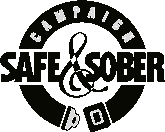 |
| Reply Card |
| Safety City Brochure |
| Buckle Up America! Week |
| Press Release |
| Proclamation |
| Key Messages |
| Strategy |
| Operation ABC: |
| Multiple Program Materials |
| Success Stories |
| Rx for Prevention |
| Strides for Safety |
| Youth Fatalities |
| Resource Materials |
| Materials Catalog |
| State Coordinators |
| Regional Offices |
| Logo Sheets |
| Down the Road |
| Don't Get Towed |
| Booster Seats |
| Kids Aren't Cargo |
| Fast Lane |
| Impaired Driving |
| Drug Driving |
| Zero Tolerance |
| Alcohol Poisoning |
| Occupant Protection |
| Air Bag Safety |
| Occupant Protection |
| Primary Safety Belt |
| Patterns for Life |
| Road to Danger? |
| Bus/Bike/Ped. Safety |
| Bus Safety Points |
| Wise Cycling |
| Ped. Safety Points |
| Prevent Ped. Crashes |
| Expect a Train |
| Women Aren't Attracted |
| Return to Main Planner Page |
Safety Tips 101
Be Smart
Always wear an approved bicycle helmet that meets current crash safety standards, and make sure it�s properly fitted. Road rash and broken bones heal; brain damage is often permanent. Consider what you are investing in your college education. Consider your future with a head injury. Wearing a bicycle helmet is common sense.
Be Thorough
Check and maintain your bicycle regularly. Keep it clean, and make sure all nuts and bolts are tight. Your brakes must work. If you prefer not to do your own bicycle maintenance, most bicycle retailers offer checkups for a modest fee.
Be Seen
Fluorescent and brightly-colored clothing and helmets help make you more visible. Reflective clothing makes you easier to see at night. If you choose to ride at night, remember that a headlight, taillight, and reflectors are vital to your safety and are required by law in most states.
Be Safe

The most important part of safe bicycling is predictability. When you are on a bicycle, you are part of vehicular traffic and must obey the same laws. Ride your bicycle with traffic, not against it. Riding on the left-hand side of the road, which is illegal, is a common cause of crashes; it puts you in an unexpected position for motorists, pedestrians, and other cyclists. Always scan your environment when approaching intersections, and obey stop signs and traffic signals.
Be Aware
Motorists often find it difficult to see bicyclists. Never assume that they see you. Try to be visible by communicating with hand signals and establishing eye contact. If you are in doubt about a motorist�s intentions, be prepared to yield in the event that the motorist does not see you. Control your speed, and watch for approaching vehicles turning left into your path. Scan the road for hazards such as potholes and drainage grates. Identify hazards in time to avoid them without swerving into traffic.
Be Sober
Remember, riding a bicycle requires skill, coordination, and a constant attentiveness to your surroundings. Alcohol and other drugs greatly decrease your ability to reason, to judge time and distance, and to control your bicycle. It is challenging enough to ride safely under the best conditions; don�t increase the risk of injury to yourself or others by bicycling while impaired.
Share the Campus
Bicycles are recognized as a great way to get around, but the recent increase in the bicycling population has resulted in much greater congestion on campuses. Remember, on shared pathways keep your speed down, and warn pedestrians and other cyclists when you are going to pass. As you approach a pedestrian from behind, calmly say something like �Passing on your left,� or �Excuse me.� Always yield to pedestrians in crosswalks.

Protect Your Property
A bicycle worth riding is worth keeping! Many bicycles that are stolen were not locked. Lock your bicycle properly. Be sure to use your lock to secure at least your back wheel and frame tube to a bicycle rack or similar immovable object. Lock your bicycle in a well-lit area where pedestrian traffic may discourage theft.
Source: Cornell University Police Bike Patrol Unit Ithaca, New York